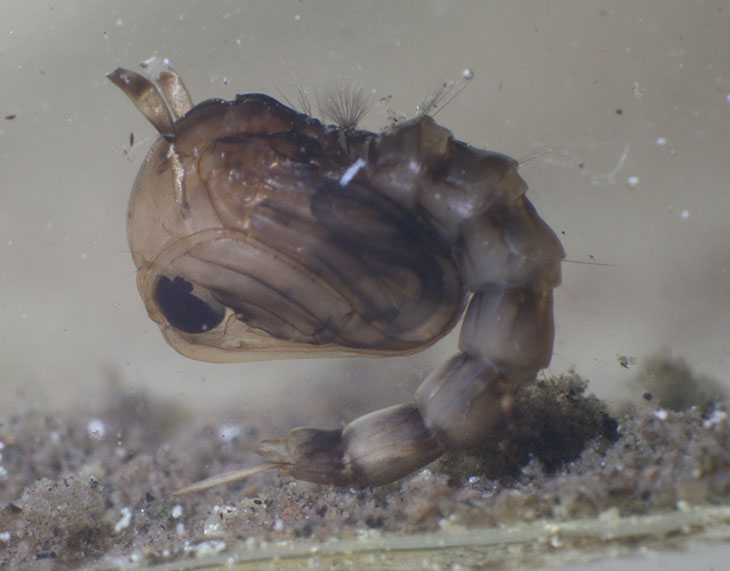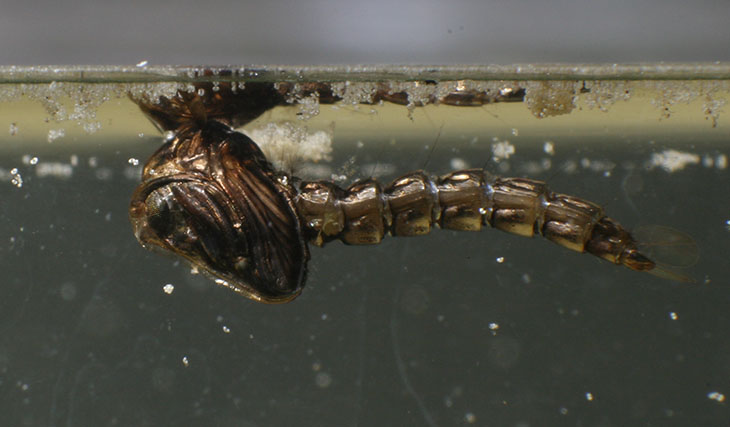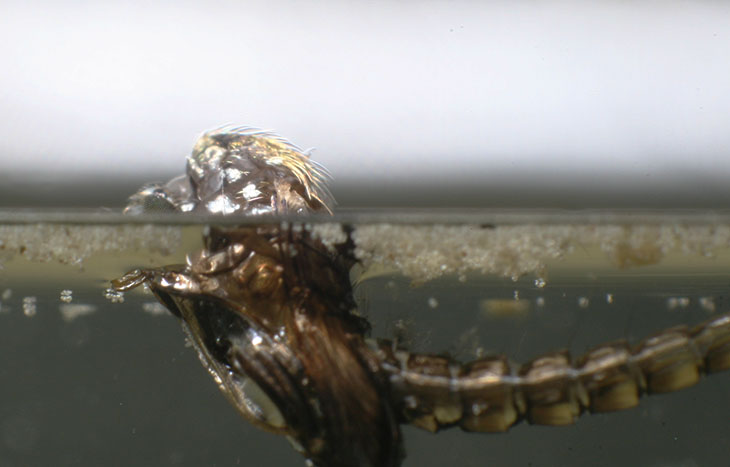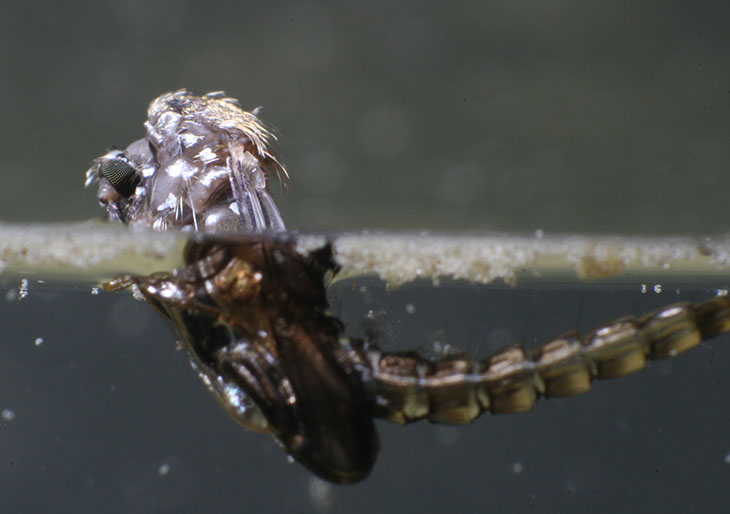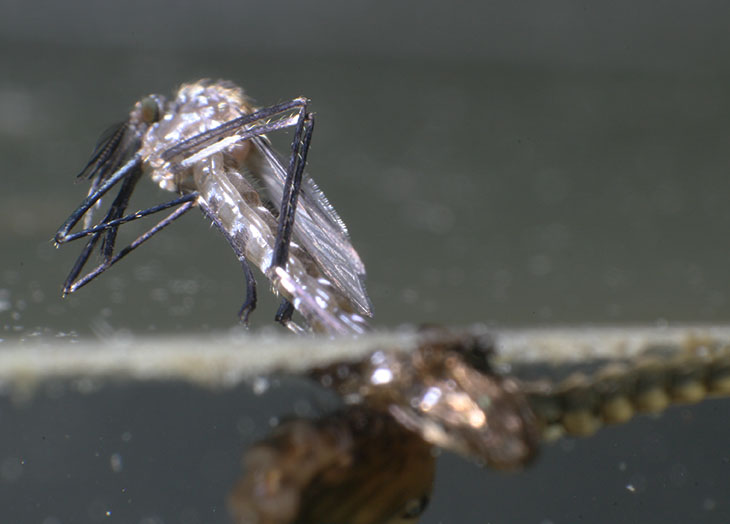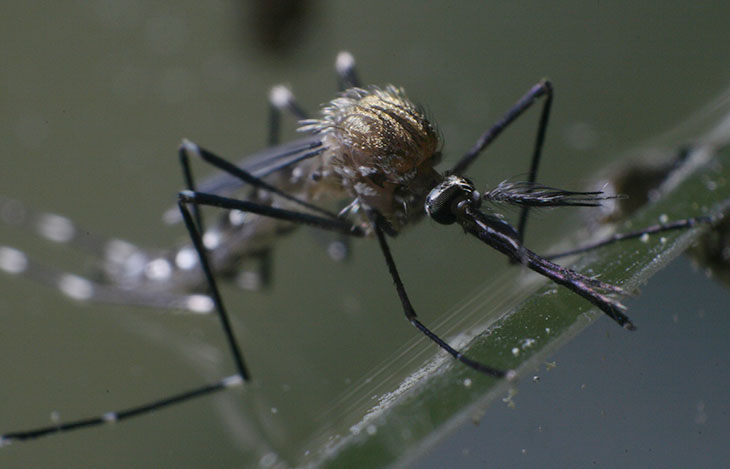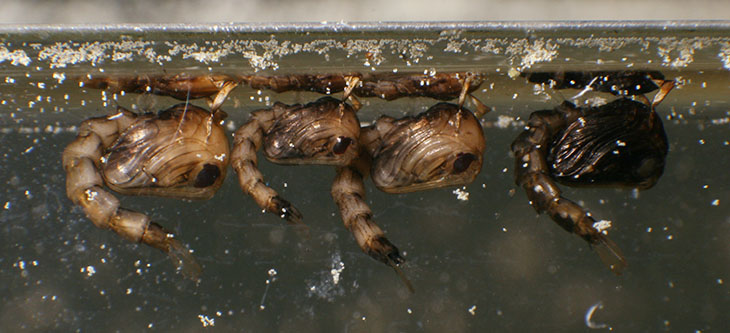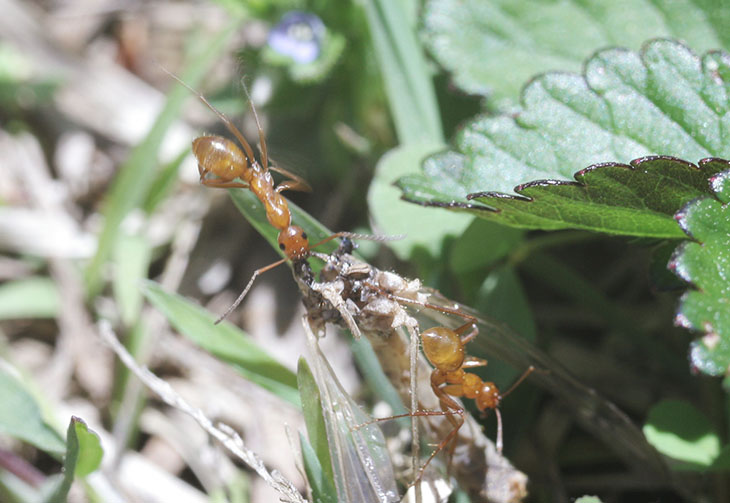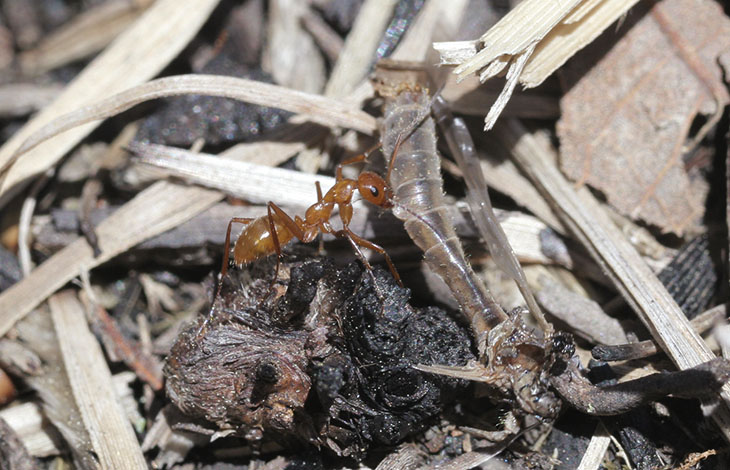It’s funny, because there really are too few instances of exactly what this post is, and I’m not sure why – it can’t possibly be because atheists are too nice about it. But considering that the last ‘But how?‘ post was about the feeble attempts at rendering a god existent by logic, it’s time to look at the other side, which is rendering a god ridiculous by logic, otherwise known as atheology. More or less, actually – atheology is indeed a concept, but it encompasses a broader approach than what I’m tackling here. The word worked best when following the last topic, so I’m using it rather frivolously here.
There are, actually, quite a few examples of logical arguments for no god – or to be more specific, showing that the god hypothesis doesn’t work at all. We’re not merely talking agnosticism here, where the lack of proof means taking a position of uncertainty. Nor are we talking about simply poking holes in religious positions and claims, such as floods and rebirth cycles – that’s child’s play, really. We’re talking about actual logical expectations that render the concepts untenable at best, but sometimes even self-defeating. An example of that one is our first:
Omniscience and omnipotence are mutually exclusive. There’s an old saw, a question that runs simply, If god is omnipotent, can he create a rock so big he cannot lift it? It’s a basic paradox examining the failed concept of infinite anything. Yet we don’t even need that to make the premise crash, because it’s pretty simple. Omniscience means that such a being not only knows everything that is, but will be as well – all consequences of actions. No religious person argues against this at all. Yet to know everything that will happen, one must be powerless to change it. If it can be changed of course, then it is not known what any future (or past) state might be, because the change has not occurred yet. Not to mention how badly this trashes all those concepts of free will and man not being a mere programmed player in the universe. Omniscience actually makes any god itself a player in the events that must unfold. However, even a lack of these extreme properties, just settling for “really powerful” and “pretty damn smart,” doesn’t eradicate the ‘man as pawn’ scenario, since anytime man’s actions or effects can be changed at whim, they’re rendered pointless against the impulses of god’s mind. It doesn’t matter how good someone is if they’re killed off before finding salvation, or if god decides to change those rules anyway. It is the ultimate slavery, not just of freedom or will, but consequence and impact as well; wave goodbye to the meaning that people claim religion provides. The only way around this is if god is completely non-intervening – which makes humans bothering with such a being pointless as well.
Everlasting life is soul-destroying. This mostly applies to the abrahamic religions that promise eternal bliss or torment, but also gathers in buddhism and its ultimate enlightenment concept. First off, all of the experiences we have, pain and pleasure and good eats and jealousy and driving really fast, are all tied to the physical body. To even exist, they need the comparative experiences, the counterpoints – we know pain because we don’t feel it constantly, we enjoy pleasure as a special reward. Perpetuating these makes them meaningless.
Rewards and punishments only serve two purposes, however. The first is mere bluff, the promise of consequences. The second is the actual demonstration of consequences, to prevent a repeat of the behavior that elicited them. In both cases, perpetual reward or punishment is utterly pointless.
Not only that, but a perpetual existence would be the most boring thing imaginable, regardless of the state we’re experiencing at the time. People really don’t grasp the idea of forever and ever, and how it would destroy anticipation, surprise, the very idea that there is something else to experience. We’re driven, right now, to accomplish certain things because we know we won’t always have the chance to – life is finite. We seek to improve our lives because improvement is always possible. Every religious person, no matter how devout, recognizes this fundamentally (yes, that’s a pun, I don’t write these blithely you know) – everyone has the same drives towards society and interactions regardless of their supposed belief in what comes afterward. Religious folk should be the most mellow on earth, frozen in their actions and desires once they know they’re guaranteed an ultimate reward transcending anything life has to offer. I’ll just leave that gigglefest hanging out there…
We must also examine how enormously pointless it would be to create a plane of existence to populate for a brief period of time as lead-in to an unchanging, perpetual state. This accomplishes… what, exactly? And is there some value to an infinitely expanding sphere of really happy souls, never changing, never going anyplace? The immediate answer from religious folk is that we cannot fathom what the real plan is, but this is fatuous handwaving – we’ve supposedly just been told this is the state of affairs, and it’s exactly what’s being addressed here; imagining that there’s something else that renders this different somehow is no more valid than imagining that it’s all horseshit (the latter is far more supported by the facts, actually.)
Not to mention that every last vestige of the whole idea, pleasure and pain and the fear of death and so on, all fit precisely (and without any special circumstances or unknown plans whatsoever) into a basically physical, evolved life form. There are no fancy scenarios that have to be created to explain why we have a sex drive if sex is a sin, and why shellfish are tasty and nutritious if we’re not supposed to eat them.
Natural laws. It’s almost stunning what some very basic physical principles can do. Everything that we do, everything that we see, experience, and even predict, boils down to, believe it or not, four simple physical forces. They’re tied into everything, so well in fact that we can predict the Higgs Boson and gravity waves. Pause for a second; we have predicted finding the after-effects of an event 13.8 billion years old. And the only reason we could actually do this is if all of it, from Day One, ran like clockwork.
Even in everyday life, we depend on this. We could not drive a car or cook a pizza if these were not incredibly, precisely dependable. We could never have built the computers we’re using now, and especially not the GPS unit that takes us to our destinations. We can map dark matter because we know what it takes to bend light, packets of energy that have traveled trillions of kilometers across the universe – these forces extend out as far as we can detect, which is a volume of space that defies any comparative analogy. And there is no penalty for breaking the laws of physics, because we cannot actually do so, nor have we ever seen it happen in the slightest. This leaves almost no place for a god to be acting.
One of the few exceptions to this, the curious traits of quantum mechanics, is what some have claimed as evidence of an acting god. There are many problems with this, including the bare fact that the odd effects of QM don’t propagate upwards all the way to the molecular level, that they remain predictable on large scales, and that random events do not translate to ‘intention’ in any useful way. This last one can be applied to just about any ‘god of the gaps’ claim made against anything that science still finds mysterious, since any property can be claimed for these mysteries – it’s evidence of extra-dimensional aliens, or suggests that we’re in a simulation – but without something testable, it remains a teapot in space.
This ties in with:
Conservation of energy. Within those four forces sits a very simple effect: that energy always acts to distribute itself evenly among all matter. In order to provide the energy that moves our vehicles along, we have to rob it from somewhere else with a higher potential, eventually leading all the way back to the sun – this is the Second Law of Thermodynamics that ignorant religious folk like to claim we don’t understand (or doesn’t even exist.) Any concentration of energy will dissipate among all surrounding matter unless held in check by one of the four forces. The burner on the stove heats the pan, which in turn heats the contents, solely because of this process.
Any creation event, any miracle, any alteration of this universe-wide interaction, requires the input of energy, which is then going to dissipate – a net gain of the energy in the universe, unless it is transferred from someplace else. Either way, there are ripple effects from these energy changes, atoms having to cope with a sudden influx, inertia being shed abruptly – depending on the size of the miracle, anything from a sudden spot of intense heat to a shockwave that could destroy planets.
The argument, of course, is that god will prevent all of the negative effects, and can not only create energy at will, he can vanish all of the after-effects. The evidence for this fails to exist, however, and Superman is impervious to bullets because he comes from Krypton – there’s no shortage of stupendous claims, but without either evidence nor value, we have nothing more than stories; excuses do not gain the value of a working theory solely through wanting them to be true. Even the scriptural accounts themselves do not provide any useful reasoning; consider that, in joshua 10, the sun and moon are halted in the sky (not, curiously enough, that the rotation of the Earth was halted – apparently god was not on board with the whole orbital physics thing), a manifestation of energy and inertia physics of a magnitude that could turn the planet into molten slag. Every molecule on and of the Earth had to be stopped in its path without any ill effect – and started again afterward, all so joshua had time to finish slaying his enemies. Because it was much more useful than god doing so himself. And don’t ask who created the enemies…
Curiously, while scientists, and merely the really observant, have never seen the slightest indication of these miraculous violations, the devout supposedly see them all the time, so the argument that god is trying to keep it hidden doesn’t pass muster. Even if a god was deciding to be selective in who witnessed the magic, wouldn’t it make more sense to demonstrate it in front of those who don’t believe?
Moreover, one is also obligated to explain why any god would establish physical laws extending throughout the vast reaches of the visible universe, only to thwart them by producing sporadic miracles – and then attempt to cover these up again.
We are physically-dependent beings. Our whole lives revolve around detecting physical properties, seeking cause-and-effect, observing patterns, and predicting consequences – and this works really, really well, responsible for every comfort, every convenience, every function of our lives from beginning to end. Even our minds, supposedly designed this way, strive for proofs, evidence, and physical manifestations of anything – these traits are related throughout every example of scripture that I’ve come across. By our very nature, we remain skeptical of stories, and realms that do not provide any form of personal experience. The religious folk that deny this, claiming we freely accept heaven and otherworldly planes of existence, are conveniently forgetting that religious artifacts, manifestations of miracles, and even prayer are all attempts to bolster belief with physical evidence, and it occurs everywhere.
The main take on this, if we accept the religious premise, is that we are designed to doubt the very existence of a creator – which makes everything about humankind an enormous game of some nature. Hyperpotent beings should have no problems with not just communicating the ‘true’ nature of existence, but even implanting it directly in our minds so doubt couldn’t even arise – yet this obviously didn’t happen.
The argument, long ago tackled, is that this is the ol’ free will thingy, permitting mankind to choose a path that leads to salvation or torment, enlightenment or repetition, advancement or retardation. Despite the long history of this claim, few ever seem to realize that it does nothing to eradicate the underlying pointlessness. Why have mankind play any game at all? Why, indeed, have mankind, period?
This leads to:
The remarkable self-absorption of both man and god. We know the universe is vast. Even the distances encompassed within our little solar system are staggering. Yet the creator of this panoply of physics seems inordinately concerned with the antics of, really, a tiny percentage of living matter in the paper-thin skin of atmosphere on just one tiny body amongst it all; the entire Earth takes up not 0.03 percent of our solar system’s mass, 99.8 of which is the sun itself – which is one of an estimated 100 billion in the Milky Way galaxy, itself one of an estimated 100-200 billion galaxies in the known universe. And not just concerned, but constantly involved (depending on which religion you choose) and neurotically dependent on the opinions thereof – apparently being superpowerful, able to create at whim, doesn’t eradicate the emotional dependency on an infinitesimal manifestation of living matter and their ridiculous antics.
Moreover, despite knowing all of this, religious folk continually insist that our actions are not only important, but part of a grand plan – we are the humble servants (exact words) of this hyperpotent being. Again, no one knows what this plan is, but we’re integral to it. And somehow, very few ever get to the point of wondering what game this could possibly be, because there’s nothing we could provide that any god couldn’t achieve without us.
Gods are incredibly petty. And this goes for even our own self-absorbed human perspective. In nearly every account given the world over, gods are surprisingly similar to fascist dictators, demonstrating all of the worst examples of the corruption of great power. While one might expect enormously potent beings to be threatened by nothing, what we see instead are myriad examples of abuse, coercion, jealousy, revenge, petulance, and even in the mildest of cases, ego and demands of offerings and sacrifice. All by themselves these are more than a little disturbing, but when considered against the claims that we are intended creations of these personalities, it becomes ludicrous. Only the mentally unbalanced becomes so upset over something they purposefully made to be exactly this way.
Further, these are all human traits, and again, we have perfectly adequate reasons why these exist and how they came about. No supernatural being has any use for emotions of any kind, since emotions are stimulants of survival behavior. Our anthropocentric tendencies insist that we can relate best to humans, and thus human analogs in gods, but the chances of an extra-dimensional being possessing identical emotions are not only infinitesimal, they could serve no function whatsoever. Even if we believe that any creative force actually possesses a personality, it is remarkably unlikely to be anything we would recognize, much less relate to.
Religion is self-affirming. While the majority of the world’s religions expend far more effort into delineating the number of things mankind should not be doing over the positive actions it should (a peculiar form of guidance and planning to be sure,) very few religious people ever find themselves on their god’s bad side, when by all rights this unfortunate state should be held by the majority of the world’s population. The devout not only consider their faith a mark of status and indeed elitism, most are adherents only of the religion they were raised within, and remain largely unfamiliar with the other manifestations of faith they pronounce their superiority of. We have to recognize that religion is serving more as emotional affirmation than any kind of behavioral guide, making it less effective than speed limits.
We cannot ignore the fact that, in service to this indulgence, some of the largest slaughters and greatest inhumanities of our species’ history have been committed, demonstrating that even if any supernatural being existed, a) their influence is remarkably weak, b) they are not the least involved in beneficence and ‘caring,’ or c) their rules for humans just aren’t working. In a few decades in the US, we managed to almost completely overturn racism, certainly eradicating the openness with which it was once practiced – but a few thousand years of god’s word hasn’t been enough to instill peace, or even humility, much less an agreement on which religion is proper. Segue to:
There is no universal similarity in the world’s religions. While we are often told that scripture and religious revelation are god’s communications to its creation, there is such a huge variety of gods related throughout the world as to render this ridiculous. Somehow we are to believe that most of the world’s populations, throughout thousands of years of history, have pursued false idols to a huge degree, but only right here, right now, the church that we attend got it exactly right. Of course.
Religious folk make a great deal out of whatever common elements they can find, such as the number of cultures with flood myths, but we should expect common elements among many cultures, especially of things that occur worldwide. No attention is paid to the differences, however, which outnumber the similarities by a hundred to one, even more when we discount any examples that might have come from cultural crossovers and absorptions. Even further, claiming that any culture at all has strayed from god’s word means an inherent recognition that religion can be entirely made up – if all those cultures aren’t following the real god, who the hell are they following? And if they’re, as proponents of a sensus divinitatis blurt out, merely getting an impression of supernatural influence without accurate details, who gets to pronounce themselves correct in such circumstances?
No religion has ever gotten the details correct. The shape and age of the Earth, the true nature of the sun and the stars, the presence of microbes and how to avoid them, what lightning is, the methods of building a strong community, the hazards of believing promises from leaders… all the kinds of information that one would not only want from divine guidance, they would have been excellent evidence in support of such. Instead, what we actually have are myriad different, conflicting, and truly spectacular creation stories, completely inaccurate depictions of the sky and bodies therein, and total indifference to most of the pitfalls humans could possibly face. Again, religious folk struggle to interpret vague passages within scripture as supporting dinosaurs or an old Earth, but no devotee ever posited these possibilities at all, much less followed them faithfully, until observations rendered them inescapably correct – it’s not really useful information if we had to find it on our own before recognizing it within scripture.
Additionally, the inaccuracies within scripture produce their own problems: either the gods imparted false information to us, or the scribes somehow got these details way wrong. In either case, the only thing it tells us is to stop paying attention to scripture. The third possibility, considered by far too many people, is that scripture is right and everything that we have observed, tested, predicted, and use every day is actually wrong. Treating this ludicrous and desperate proposal with an ounce of seriousness just for giggles, this means that nothing that we do or observe is trustworthy – including what we read from scripture. That’s only a recipe for a rubber room.
No religion has produced evidence, prediction, or function beyond the merely emotional. While absolutely brimming with promises, properties, and guidance, no religion has managed to achieve even a simple improvement in our lives beyond the personal; the most theocratic states are among those with the lowest standards of living and the most oppression, falling in with the dictatorships. In US prisons at least, the percentage of religious inmates is significantly higher than the general population, instead of far lower as one would reasonably expect. Religious miracles are always either unsubstantiated folklore or vague examples easily explained by other means. Scriptural miraculous events have left no traces to be found, despite their claimed worldwide impact. Studies on the value of prayer turn up no effect except bias. Predicted events from scripture have repeatedly failed to manifest. No buddhist ever displays stigmata; no muslim ever drops dead from a shaman’s curse. In short, religion is a cultural artifact, manifested nowhere else, in no other way. We cannot use it to predict reactions, prepare for future events, or even form a rough guideline of the behavior of the adherents.
As numerous science-fiction stories have delved into, if we attempted to explain the function and value of religion to an alien species, we wouldn’t get anywhere – we can’t even do this for ourselves without blind selectivity. The only reason we accept any religion at all is because we’re hopelessly influenced by what others think; religion is spread by cultural pressure. Any comparison of the world’s various faiths for accuracy or explanatory values comes up poorly – adherents can find plenty wrong with every religion but their own, while excusing the exact same kinds of illogical and improbable properties of their own that they claim makes all other faiths corrupt. No religious culture has jumped ahead of all others in any standard one cares to name, while cultures with low religiosity show much higher standards of living, a correlation for which no one has yet managed to find another explanation.
Now, let’s be fair. I said in the previous ‘But how?’ post that logic isn’t all it’s cracked up to be: logic is only the extrapolation of dependable experience, or accepted traits, into rules or predictions, but if the experience is wrong or the traits inadequately understood, logic isn’t sufficient to render an accurate answer. Therefore, a logical argument that no gods exist is worthless, right?
Well, that depends – especially since that question above is a logical posit in itself ;-). First off, most of these are established by the very properties that religious folk claim, and are thus self-defeating. If the details are wrong, well, so is the religion that relies on them.
However, the real test of any logical argument is the evidence that it manifests. If we understand this property and that reaction, then we should expect to see so-and-so when combined – if the result is as predicted, we know that we understand the properties enough to produce something with functionality. There are numerous properties that we can expect to see from supernatural beings (despite the attempt to hide them away from our perceptions) and plenty of opportunities for religion to show worth. Yet positive religious properties are scarce, and predictions are even scarcer; we have more claims for why these don’t exist than actual examples that they do. “It’s all a plan we don’t know,” and “god works in mysterious ways” and “god is present in the areas science hasn’t found answers for” and “god made it all look like he didn’t exist” and “the long list of evidence disproving scripture is a test” – none of these are found anywhere in scripture. But while there is no such thing as proving a negative, we can show that the expected results from any positive claim do not manifest, or are logically inconsistent.
Any and all excuses for a lack of positive evidence can, and should, immediately be dismissed; the point should never be to justify belief despite a void of proof, but to demonstrate the positive, beneficial aspects of any hypothesis. It’s not enough to know a bunch of people with faith, and the fact that ‘faith’ is such a vague, contextual term shows that everyone knows it’s a void – especially when it can be applied with equal facility to every other sect that must be false. Value derives from something that works without faith, without excuses, without someone needing to believe in its existence. We can feel much more comfortable calling something ‘truth’ if it works the same for everyone, regardless of their cultural upbringing or predilection not to believe it. Vaccinations work for buddhists, hindus, rastafarians, christians, muslims, and atheists – despite the fact that their development required utilizing a theory that some of those faiths deny even exists. That’s value; that’s functionality.
There is a common concept, used not just in courts but throughout science as well, called the ‘preponderance of evidence.’ While there may be many different ways that each item of evidence can have come about, if just one scenario can satisfy all of them, probability favors this as the correct one – especially if other explanations involve highly improbable events, coincidences, or inexplicable behavior. So while countless arguments may be forwarded in response to the list above, I’d be very interested to see if anyone manages to find just one that covers them all, to see if it’s any better than the one that already exists: that there are no gods.
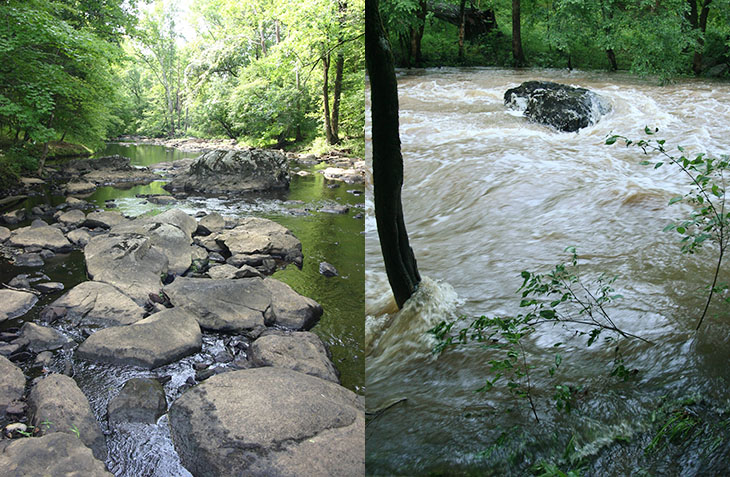
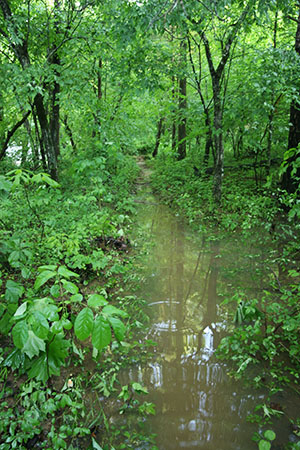 This is part of the path that winds alongside the river, only about 20 cm under water at this point so I was still able to follow it – I spend the non-winter months in waterproof sandals specifically for conditions like this, because I think it’s silly to let a little water block me from something interesting. My feet are so used to this that I rarely notice the water temperature at all, unless it gets really extreme. [An example of this was when my dad visited one winter and we went out to the Outer Banks. He snagged a favorite and expensive fishing lure on something not far offshore, while casting in Croatan Sound off Roanoke Island, and I waded in barefoot to try and retrieve it – the water temperature did not exceed 4°c (40°f.) It took two attempts and became pretty painful, turning my lower legs beet red, but I got the lure and recovered quickly. I still find the people who go swimming in freezing weather to be morons, though.]
This is part of the path that winds alongside the river, only about 20 cm under water at this point so I was still able to follow it – I spend the non-winter months in waterproof sandals specifically for conditions like this, because I think it’s silly to let a little water block me from something interesting. My feet are so used to this that I rarely notice the water temperature at all, unless it gets really extreme. [An example of this was when my dad visited one winter and we went out to the Outer Banks. He snagged a favorite and expensive fishing lure on something not far offshore, while casting in Croatan Sound off Roanoke Island, and I waded in barefoot to try and retrieve it – the water temperature did not exceed 4°c (40°f.) It took two attempts and became pretty painful, turning my lower legs beet red, but I got the lure and recovered quickly. I still find the people who go swimming in freezing weather to be morons, though.]
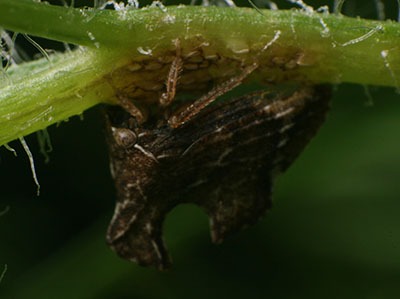 This is an Entylia carinata, no apparent common name, and a significant number appeared on the plants overnight it seems. They run about 5mm in length, and have a tendency (like all ‘hoppers) to scuttle around to the back side of the stem when someone leans close, so it took quite a few tries to get a nice shot. The pic at right, in fact, is one I consider a ‘miss’ except for one thing: I’m pretty sure the discoloration of the plant stem beneath the treehopper is from the damage that they do while sucking out the sap. The amount of nutrients they extract from the sap is minimal, so they draw a lot and process it through their systems pretty quickly, excreting the rest as ‘dew’ that is often harvested by ants. No ants were taking advantage of these, however, even though the species is known as a favorite of them. I’ll keep my eyes open, since while I have a few images of ants farming leafhoppers and aphids, I’d still like some more detailed examples.
This is an Entylia carinata, no apparent common name, and a significant number appeared on the plants overnight it seems. They run about 5mm in length, and have a tendency (like all ‘hoppers) to scuttle around to the back side of the stem when someone leans close, so it took quite a few tries to get a nice shot. The pic at right, in fact, is one I consider a ‘miss’ except for one thing: I’m pretty sure the discoloration of the plant stem beneath the treehopper is from the damage that they do while sucking out the sap. The amount of nutrients they extract from the sap is minimal, so they draw a lot and process it through their systems pretty quickly, excreting the rest as ‘dew’ that is often harvested by ants. No ants were taking advantage of these, however, even though the species is known as a favorite of them. I’ll keep my eyes open, since while I have a few images of ants farming leafhoppers and aphids, I’d still like some more detailed examples.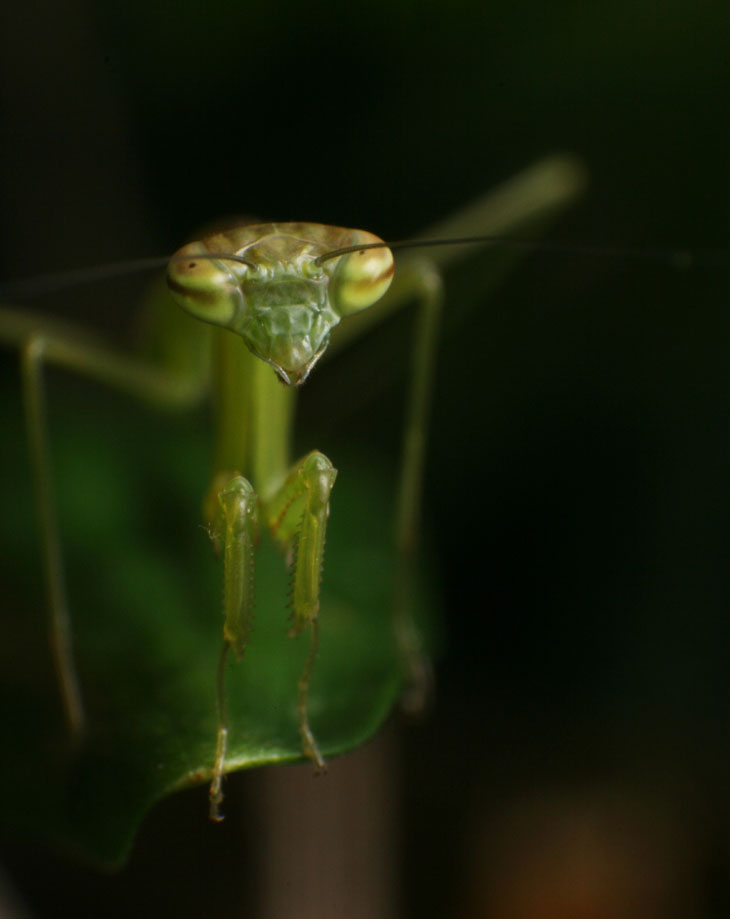





















































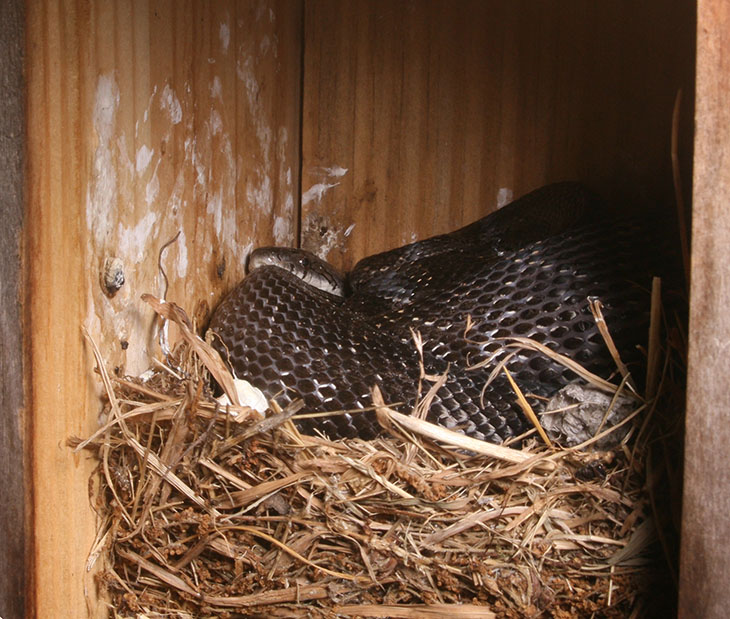
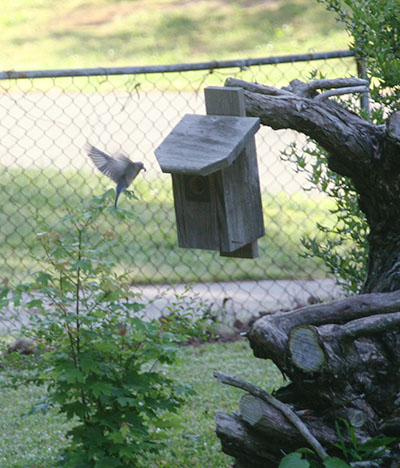 Some of this is perhaps our fault. We’d placed two nest boxes on stumps that had once been huge bushes, which the landlord’s inept assistants had hacked down to some strange modern sculptures – I suspect they misinterpreted their instructions, since the pampas grass in the yard needs to be cut back to nothing each winter. It’s a grass, it grows back; the bushes didn’t. But it means the nest boxes were placed lower to the ground on a handy climbing surface, and black rat snakes are
Some of this is perhaps our fault. We’d placed two nest boxes on stumps that had once been huge bushes, which the landlord’s inept assistants had hacked down to some strange modern sculptures – I suspect they misinterpreted their instructions, since the pampas grass in the yard needs to be cut back to nothing each winter. It’s a grass, it grows back; the bushes didn’t. But it means the nest boxes were placed lower to the ground on a handy climbing surface, and black rat snakes are 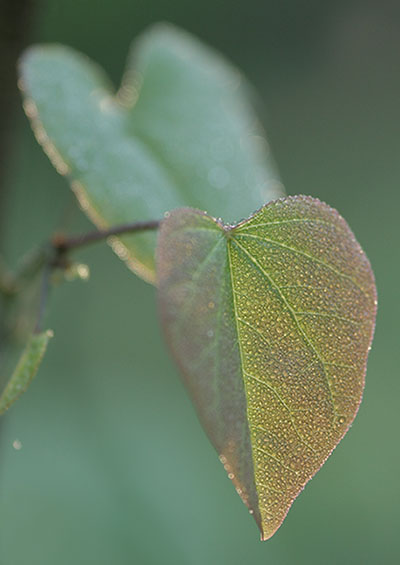 A couple of pics from early yesterday morning, while it was cool and humid – I was going to put these up last evening but the internet went down. I haven’t been posting much, and this is likely to continue for a while, but I had the chance to chase a few images in the morning. I made an attempt to spot some of the juvenile mantids, since they’re photogenic when
A couple of pics from early yesterday morning, while it was cool and humid – I was going to put these up last evening but the internet went down. I haven’t been posting much, and this is likely to continue for a while, but I had the chance to chase a few images in the morning. I made an attempt to spot some of the juvenile mantids, since they’re photogenic when 
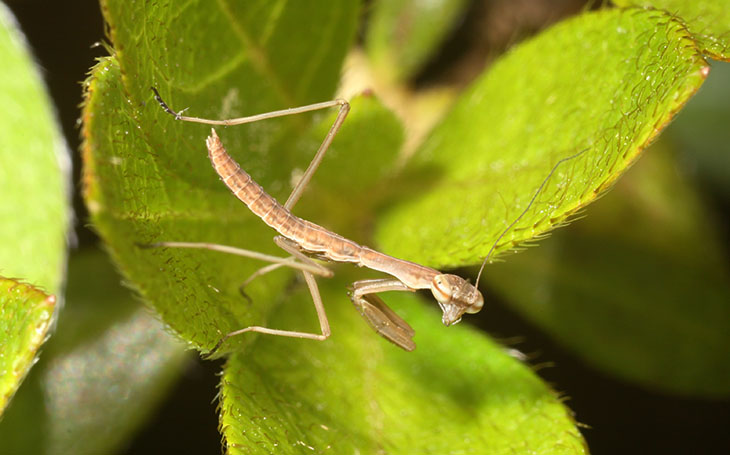


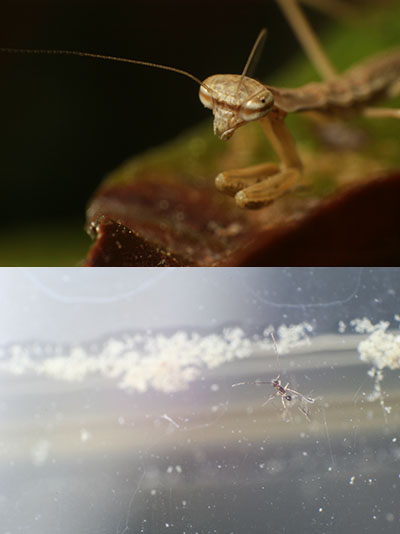 I realize I’m using rather disparaging terms about size, from my biased perspective, so let’s drop the diminutives and look at a scale comparison. Seen here are two images shown full-frame – this is what I captured with the camera, before cropping. They were taken at the same magnification, and we already know how big the mantis is, so this makes the fairyfly less than 0.5mm in body length, stretching all the way out to maybe 2mm with the wings and antennae – little wonder I could barely make out any details. If it weren’t for the fact that I was already watching subjects behind it, with a contrasting background, I never would have spotted it at all. I look at things like this with a certain level of awe; there’s a brain in that
I realize I’m using rather disparaging terms about size, from my biased perspective, so let’s drop the diminutives and look at a scale comparison. Seen here are two images shown full-frame – this is what I captured with the camera, before cropping. They were taken at the same magnification, and we already know how big the mantis is, so this makes the fairyfly less than 0.5mm in body length, stretching all the way out to maybe 2mm with the wings and antennae – little wonder I could barely make out any details. If it weren’t for the fact that I was already watching subjects behind it, with a contrasting background, I never would have spotted it at all. I look at things like this with a certain level of awe; there’s a brain in that 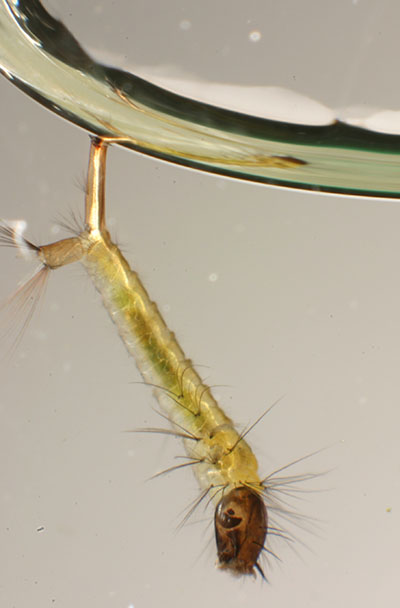 A couple of years ago, I captured a particular sequence of images that didn’t quite cut it, as far as I was concerned, and I’ve been trying to get a better set ever since. This evening, I was successful.
A couple of years ago, I captured a particular sequence of images that didn’t quite cut it, as far as I was concerned, and I’ve been trying to get a better set ever since. This evening, I was successful.